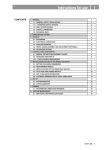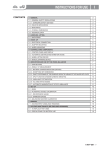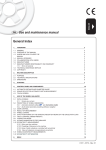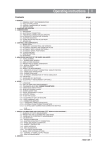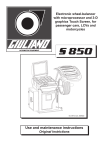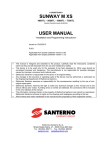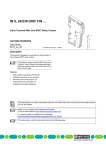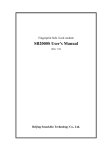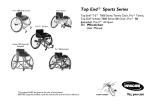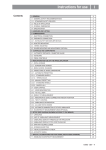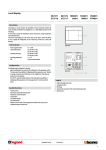Download PDF Manual
Transcript
I Instructions for use CONTENTS 1 - GENERAL 3 1.1 - GENERAL SAFETY REGULATIONS 3 1.1.1 - STANDARD SAFETY DEVICES 3 1.2 - FIELD OF APPLICATION 3 1.3 - OVERALL DIMENSIONS (STANDARD GUARD) 3 1.4 - TECHNICAL DATA 4 2 - HANDLING AND LIFTING 4 3 - STARTUP 4 3.1 - ANCHORING 4 3.2 - ELECTRICAL CONNECTION 5 3.3 - ADAPTER MOUNTING 5 3.4 - WHEEL GUARD ASSEMBLY AND ADJUSTMENT (OPTIONAL) 5 3.5 - WD SPACER 5 4 - CONTROLS AND COMPONENTS 5 4.1 - AUTOMATIC DISTANCE AND DIAMETER GAUGE 5 4.2 - KEYBOARD AND DISPLAY 6 4.2.1 - FUNCTION MENU MANAGEMENT 7 5 - INSTRUCTIONS FOR USE OF THE WHEEL BALANCER 8 5.1 - USING THE GAUGE INSTALLED ON THE MACHINE 8 5.1.1 - DATA SETTING 8 5.2 - AUTOMATIC PRESETTING 8 5.2.1 - STEEL OR ALUMINUM WHEEL RIMS. SPRUNG COUNTERWEIGHTS 8 5.2.1.1 - STATIC & COMBINED MODES 9 5.2.2 - RIMS WITH INTERNAL COUNTERWEIGHT 9 5.3 - MEASUREMENT RESULT 10 5.4 - RECALCULATION OF THE UNBALANCE VALUES 10 5.5 - EXACT POSITIONING OF THE ADHESIVE WEIGHT BY MEANS OF THE GAUGE WITH CLIPS 11 5.6 - SPLIT FUNCTION (HIDDEN WEIGHT) 12 5.7 - OUT OF BALANCE OPTIMIZATION 13 5.8 - AUTOMATIC MINIMISATION OF STATIC UNBALANCE 14 6 - SET-UP 15 6.1 - AUTODIAGNOSTICS 15 6.2 - AUTOCALIBRATION 15 6.3 - MANUAL DIMENSION PRESETTING (use only in particular cases or for test) 16 6.3.1 - STEEL WHEEL RIMS (use for setting dimensions in AUTOCALIBRATION) 16 6.3.2 - ALUS RIMS 16 6.3.2.1 - ALUS VARIANT WITH INSIDE CLAMP WEIGHT 17 6.4 - AUTOMATIC GAUGES CALIBRATION 17 6.4.1 - RIM DISTANCE GAUGE 17 6.4.2 - DIAMETER GAUGEE40 MM 18 7 - ERRORS 19 7.1 - INCONSISTENT UNBALANCE READINGS 20 8 - ROUTINE MAINTENANCE 20 8.1 - REPLACING THE PROTECTION FUSES 20 I 0615 GB - 1 I 0615 GB - 2 1 - GENERAL ► 1.1 - General safety regulations The wheel balancer may only be used by duly authorized and trained personnel. The wheel balancer must not be used for purposes other than those described in the instruction manual. The wheel balancer must not be modified in any way except for those modifications made explicitly by the manufacturer. Do not remove the safety devices. Any work on the machine must be carried out by specialised personnel only. Avoid using strong jets of compressed air for cleaning. Use alcohol to clean plastic panels or shelves (AVOID LIQUIDS CONTAINING SOLVENTS). Before starting the wheel balancing cycle, make sure that the wheel is securely locked on the flange. The machine operator must not wear clothes with flapping parts. Do not allow unauthorized personnel to approach the wheel balancer when the cycle is running. Avoid placing objects in the base which could impair the correct operation of the wheel balancing machine. ► 1.1.1 - Standard safety devices Stop push button for stopping the wheel under emergency conditions. The wheel guard is not compulsory since the balancing speed is less than 100 min-1. ► 1.2 - Field of application The machine is designed for balancing wheels of cars, light commercial vehicles or motorcycles weighing less than 75 kg. It can be operated in a temperature range of 0° to + 45° C. The following functions are provided: ALUS; SPLIT; Unbalance optimisation; Autodiagnostics; Autocalibration. ► 1.3 - Overall dimensions (standard guard) 1 I 0615 GB - 3 ► 1.4 - Technical data Single-phase power supply 115 / 230 V - 50/60 Hz Protection class IP 54 Max. power absorbed 0,8 Kw Balancing speed < 100 min-1 Cycle time for average wheel (14 kg) 6-8 seconds Max. resolution of measurement 1 gram Position resolution ± 1.4 ° Average noise < 70dB (A) Rim-machine distance 0 - 265 mm Rim width setting range 1.5” - 20” or 40 - 510 mm Diameter setting range 10” - 30” or 265 - 765 mm 2 - HANDLING AND LIFTING 2 2a NOTE: DO NOT LIFT THE WHEEL BALANCER USING OTHER GRIPS . 3 - STARTUP ► 3.1 - Anchoring The machine can operate on any flat non resilient floor. Make sure that the machine rests solely on the three support points provided (Fig.2a). NOTE: If possible, it is advisable to anchor to the floor using relative mounting feet (see fig. 2a) in the event of continual use with wheels weighing over 35 Kg. I 0615 GB - 4 ► 3.2 - Electrical connection The machine is supplied with a single-phase mains cable plus earth (ground). The power supply voltage (and mains frequency) is indicated on the machine identification plate and cannot be changed. Connection to the mains must always be made by expert personnel. The machine must not be set up without proper earthing. Connection to the mains should be through a slow acting safety switch rated at 3 A (230V) or 8 A(115 V). See enclosed diagram. ► 3.3 - Adapter mounting The wheel balancer is supplied complete with cone adapters for fixing wheels with a central hole. 3 Other optional adapters can be mounted: a. Remove the threaded end-piece A after unscrewing the screw B. b. Mount the new adapter (see attached sheets). NOTE: CAREFULLY CLEAN THE COUPLING SURFACES BEFORE PERFORMING ANY OPERATION. ► 3.4 - Wheel guard assembly and adjustment (optional) 1. Fasten the components to the base as illustrated in specific exploded view. 2. The position of the wheel guard when closed can be adjusted with relative screw accessible at the back. Correct position is horizontal. 3. Check that the microswitch is held down when the guard is closed. 4. Adjust the angular position of microswitch control. Note: Do not lean on the guard during the wheel balancing cycle. ► 3.5 - WD spacer When balancing very wide wheels (9”), there is not enough space to turn the distance gauge. To move the wheel away from the machine side, fit the WD spacer on the flange body and secure it with the standard issue nuts. When centring the wheel with cone from the inside, mount the DC spacer to obtain spring thrust. DC 3a WD Cone Spring 4 - CONTROLS AND COMPONENTS ► 4.1 - Automatic distance and diameter gauge Allows automatic measurement of the distance from the machine and the wheel diameter at the counterweight application point. The same gauge can be used to position the counterweights correctly inside the wheel, using the specifi c function that suggests the position memorised during measurement inside the rim. I 0615 GB - 5 ► 4.2 - Keyboard and display 4 1 2 18 9 8 3 13 3-4 5 6 7 8 9 10 14 15 11 16 12 4 5 1-2 17 8 6 7 Digital readouts, AMOUNT OF UNBALANCE, inside/outside Digital readouts, POSITION OF UNBALANCE, inside/outside Inside correction mode selection button Indicators, correction mode selected Outside correction mode selection button Special function indicators Manual WIDTH/DISTANCE/DIAMETER setting buttons and MENU selection 10 11 12 13 14 15 16 17 18 Push button, FUNCTION MENU Balancing cycle stop button Balancing cycle start button Position repeater push button Push button, SPLIT (unbalance resolution) MENU selection confirmation pushbutton Push button, unbalance reading < 5 g (.25 oz) Unbalance optimization selection pushbutton Grams/ounces selection pushbutton Press buttons only with your fingers. Do not use the counterweight grippers or other pointed objects. I 0615 GB - 6 ► 4.2.1 - Function menu management mm/inch diameter CONFIRM mm/inch width CONFIRM start from guard closing CONFIRM approx. -5 g or 0.1-0.25 oz CONFIRM See chapter on AUTODIAGNOSTICS See chapter on AUTOCALIBRATION * Calibration of automatic RIM DISTANCE gauge * Calibration of automatic DIAMETER gauge RETURN TO MEASUREMENT FRAME * N.B.: If such indications fail to appear, contact Technical Service. I 0615 GB - 7 5 - INSTRUCTIONS FOR USE OF THE WHEEL BALANCER ► 5.1 - Using the gauge installed on the machine ► 5.1.1 - Data setting 5 For clamp weights, use the gauge in the top position A. For adhesive weights, use the gauge as preferred in top position A or bottom position B. POS. A Note: Always use the round part of the striker plate resting on the rim. POS. B 5a Indication of gauge in movement ► 5.2 - Automatic presetting The machine automatically detects the correct balancing program for steel and aluminium rims (ALUS). The counterweight position proposed may be changed using the two / buttons. ► 5.2.1 - Steel or aluminum wheel rims. Sprung counterweights 5b 5c Pull out the gauge as far as the inner edge of the rim. Hold it in this position until the symbol shown in Fig. 5d is displayed. 5d Indication of dimensions acquired Return the gauge to rest position. The machine has automatically detected DISTANCE + DIAMETER and goes to MANUAL WIDTH SETTING. b - The nominal width is normally stamped on the rim; if not, proceed to measure dimension “b” with the calibre gauge (supplied as standard). I 0615 GB - 8 5e ► 5.2.1.1 - Static & combined modes After calibration as per STEEL OR ALUMINUM WHEEL RIMS. SPRUNG COUNTERWEIGHTS, it is possible to modify the / position of the correction weights using the buttons. STATIC: Select by pressing Balancing of light alloy rims with application of adhesive weights on the shoulders of the rims. Combined balancing: adhesive weight on the outside and clip-on weight on the inside. Combined balancing: adhesive weight on the inside and clip-on weight on the outside. ► 5.2.2 - Rims with internal counterweight 6 Slide out the gauge on the LH side, at the point where a weight is to be fitted. Wait until the symbol shown in Figure 5d is displayed. Pull it out further towards the right plane and wait until the symbol shown in Figure 6a is displayed. The wheel balancer automatically identifi es ALUS mode. 6a Counterweight position automatically suggested. can be used to set the alternative position indicated. I 0615 GB - 9 ► 5.3 - Measurement result 7a Inside correction 7b Outside correction After performing a balancing spin, the amounts of unbalance are shown on the digital readouts. The illuminated LEDs 3 and 4 indicate the correct angular position of the wheel to mount the counterweights (12 o’clock). If the unbalance is less than the threshold value selected, is displayed instead of the unbalance value; with the values below the threshold can be read, selected gram by gram. Note : in the case of wheels with a diameter less than or equal to 13” and at temperature conditions near 0°, the wheel balancer automatically inserts a special measuring cycle composed of two successive measurements. The accuracy of the unbalance values and the reliability of the wheel balancer remain unchanged. This type of operation is reset each time the wheel balancer is started. ► 5.4 - Recalculation of the unbalance values Press I 0615 GB - 10 after new setting of the measurement. ► 5.5 - Exact positioning of the adhesive weight by means of the gauge with clips - Press the button if using the correction method with weights on the inside of the rim. - Fit the correction weight in the specifi c gauge seat with the adhesive part facing upwards - bring the wheel into correct angular position for the plane to be corrected. - Pull the gauge further outwards. - Return the gauge to the rest position. INSIDE CORRECTION POSITION OUTSIDE CORRECTION POSITION 8 - rotate the gauge until the correction weight adheres to the rim - the fact that the weight application position is no longer vertical (Fig. 8) is automatically compensated - to cancel this function, press button again. N.B. : It is not possible to put automatically the correction weight in the Fig.5 POS. B position; always rotate the rim in Fig.5 POS.A upwards. I 0615 GB - 11 ► 5.6 - SPLIT function (hidden weight) The SPLIT function is used to position the adhesive weights behind the wheel spokes so that they are not visible. This function should be used only in the case of static unbalance or where the hidden adhesive weight is to be applied on the outside. Input the wheel dimensions and do a spin. Start the SPLIT function as follows: Example of display prior to SPLIT function - Place the wheel in the outside unbalance correction position. - Set one of the top spokes (preferably the one to the left of the unbalance) to 12 o’clock. - Press the button - Follow the UP/DOWN indication of the positioning LEDs and set the second top spoke to 12 o’clock. - Press button 15 - Set the first split unbalance to correction position 1 30 15 30 - Correction position 1 15 30 - Set the second split unbalance to correction position 2 30 15 N.B.: - Correction position 2 If error 24 is displayed, repeat the SPLIT function ensuring that the minimum distance between the spokes is greater than 18 degrees. If error 25 is displayed,repeat the split function ensuring that the maximum distance between the spikes is smaller than 120 degrees. To return to normal unbalance display, press any button. To carry out a new spin, press the I 0615 GB - 12 button. ► 5.7 - Out of balance optimization - This function serves to reduce the amount of weight to be added in order to balance the wheel - It is suitable for static unbalance greater than 30 g. - It improves the residual eccentricity of the tyre. No previous unbalance measurement Unbalance already measured unbalance measurement - With a piece of chalk make a reference mark on the flange and the rim - With the aid of a tyre remover, turn the tyre on the rim by 180° - Refit the wheel in such a way that the reference marks on the rim and the flange coincide. - RH display: percentage reduction value - LH display: actual static unbalance value which can be reduced by rotation TYRE POSITION - Mark the two positions of the rim and tyre, and turn the tyre on the rim until the positions correspond in order to obtain the optimization on the display. RIM POSITION CANCEL OPTIMISATION IN ANY PHASE. I 0615 GB - 13 ► 5.8 - Automatic minimisation of static unbalance Initial unbalance Phase shift Possible approximations static residue With traditional wheel balancer static residue static residue static residue Choice with minimum static unbalance This program is designed to improve the quality of balancing without any mental effort or waste of time by the operator. In fact, using the normal weights available on the market (pitch of 5 in every 5 g) and applying the two counterweights which a conventional wheel balancer rounds to the nearest value, a residual static unbalance of up to 4 g may result. The damage of such approximation is emphasized by the fact that static unbalance is the cause of most disturbances on vehicles. This new function automatically indicates the optimum entity of the weights to apply by approximating them in an “intelligent” way according to their position in order to minimize residual static unbalance. I 0615 GB - 14 6 - SET-UP 6.1 - Autodiagnostics Performs tests useful for maintenance staff. ► 6.2 - Autocalibration For autocalibration proceed as follows: 1. Fit a wheel with steel rim of average dimensions on the shaft. Example 6” x 14” (± 1”) 2. Set the exact dimensions of the wheel mounted. SETTING INCORRECT DIMENSIONS WILL RESULT IN THE MACHINE NOT BEING PROPERLY CALIBRATED AND HENCE ALL THE SUBSEQUENT MEASUREMENTS WILL BE INCORRECT UNTIL A NEW AUTOCALIBRATION IS PERFORMED WITH THE CORRECT DIMENSIONS!! - Perform a spin under normal conditions. - Add a 60 g. sample weight (2.00 oz) on the outside in any angular position. - Shift the sample weight from the outside to the inside keeping the same angular position. - Turn the wheel until the sample weight is in the 12 o’clock position. END OF AUTOCALIBRATION CANCEL AUTOCALIBRATION IN ANY PHASE. I 0615 GB - 15 ► 6.3 - Manual dimension presetting (Use only in particular cases or for test) ► 6.3.1 - Steel wheel rims (use for setting dimensions in AUTOCALIBRATION) 9 b a d - Setting: To enable the setting, hold the button the button down for more than 3 seconds, then select the dimension by pressing again. - Set the distance “a” between the inside of the wheel and the machine - Set the nominal width, normally indicated on the rim, or measure the width “b” using the caliper gauge supplied (see fig. 5e). - Set the nominal diameter “d” indicated on the tyre. N.B.: This setting is also valid for the correction modes indicated at “STATIC & COMBINED MODES”. dI dE 10 ► 6.3.2 - ALUS rims 0 gauge aI aE - Setting: To enable the setting, hold the button the button down for more than 3 seconds, then select the dimension by pressing again. Note: Hold the button down for more than 2 seconds when the value of any one of the dimensions appears on the display. Note: not setting dE as it is automatic, dE = dI - 1”. I 0615 GB - 16 dI ► 6.3.2.1 - ALUS variant with inside clamp weight 11 dE 0 gauge aI aE - Setting: To enable the setting, hold the button the button down for more than 3 seconds, then select the dimension by pressing again. (Nominal) Note: Hold the button down for more than 2 seconds when the value of any one of the dimensions appears on the display. Note: not setting dE as it is automatic, dE = dI - 2”. 6.4 - Automatic gauges calibration ► 6.4.1 - Rim distance gauge - Leave the distance gauge in rest position and press - Bring the gauge in contact with the flange surface and press CORRECT CALIBRATION - Return the gauge to rest position. - The wheel balancer is ready for operation. N.B.: In the event of errors or faulty operation, the writing “r.P.” appears on the display : shift the gauge to the rest position and repeat the calibration operation exactly as described above. If the error persists, contact the Technical Service Department. In the event of incorrect input in the rim distance gauge calibration function, press to cancel it. I 0615 GB - 17 ► 6.4.2 - Diameter gauge E40 mm Place the round part of the gauge terminal on the flange as shown in the figure and press . - The number 289 ± 3° appears on the left display . - Turn the gauge downward position the round part of the gauge terminal at 40 mm (radial distance) from the flange as indicated in the figure. 40 mm 40 mm - The number 289 ± 3° should appear on the left display. - If not, press the button holding the gauge still at 40 mm: the number 289 appears on the left display. - Return the gauge to rest position. In the event of incorrectly accessing the diameter gauge calibration function, press I 0615 GB - 18 to cancel it. 7 - ERRORS During machine operation there may be various causes of malfunctioning which, if detected by the microprocessor, are indicated on the display: ERRORS CAUSES CONTROLS Black The wheel balancer does not come on. 1. 2. 3. Check proper connection to the mains. Check and if necessary replace the fuses on the power board. Replace the computer board. Err. 1 No rotation signal. 1. 2. Check belt tautness. Check functioning of the phase generator and, in particular, the reset signal. Replace the phase generator. Replace the computer board. 3. 4. Err. 2 Too low speed during measurement. During the unbalance measurement revolutions, the wheel speed has fallen to below 42 rpm. 1. Too high unbalance. 1. 2. 3. 4. 2. 3. 4. Err. 3 5. Check that a vehicle wheel has been mounted on the wheel balancer. Check belt tautness. Check functioning of the phase generator and, in particular, the reset signal. Replace the computer board. Check the wheel dimension setting. Check the sensor connections. Run the machine calibration function. Mount a wheel with a more or less known unbalance (less than 100 grams) and check the machine response. Replace the computer board. Err. 4 Rotation in opposite direction. After pressing [START], the wheel starts turning in the opposite direction (anticlockwise). 1. Verify the connection of the UP/DOWN - RESET signals on the phase generator. Err. 5 Guard open The [START] pushbutton was pressed without first closing the guard. 1. 2. 3. 4. Reset the error. Close the guard. Verify the function of the protection uSwitch. Press the [START] button. Err. 7 / Err. 8 / Err. 9 NOVRAM parameter read error 1. 2. 3. 4. 5. Repeat machine calibration Shut down the machine. Wait for at least ~ 1 min. Restart the machine and check proper functioning. Replace the computer board. Err. 11 Too high speed error. The average spinning speed is greater than 240 rpm. 1. 2. Check if there is any damage or dirt on the timing disc. Check functioning of the phase generator and, in particular, the reset signal. Replace the computer board. 3. Err.14/ Err.15/ Err.16/ Err.17/ Err. 18/ Err. 19 Unbalance measurement error. 1. 2. 3. 4. 5. Check functioning of the phase generator. Check the sensor connections. Check the machine earthing connection. Mount a wheel with a more or less known unbalance (less than 100 grams) and check the machine response. Replace the computer board. Err.21 Motor on for more than 15 seconds. 1. 2. 3. Check functioning of the phase generator. Check the connections on the power board. Replace the computer board. Err.22 Maximum number of spins possible for the unbalance measurement has been exceeded. 1. Check that a vehicle wheel has been mounted on the wheel balancer. Check belt tautness. Check functioning of the phase generator and, in particular, the reset signal. Replace the computer board. 2. 3. 4. Err. 24 Distance between the spokes smaller than 18 degrees. 1. 2. Err. 25 Distance between the spokes greater than 120 degree 1. 2. The minimum distance between the spokes where to split the unbalance must be greater than 18 degrees Repeat the SPLIT function increasing the distance between the spokes. The minimum distance between the spokes where to split the unbalance must be smaller than 120 degrees Repeat the SPLIT function increasing the distance between the spokes. I 0615 GB - 19 Err.32/ Err.33/ Err.34/ Err.35/ Err.36/ Err.37 Errors related to test functions of the wheel balancer. 1. Cancel the error and continue using the wheel balancer as normal. ► 7.1 - Inconsistent unbalance readings It may occur that after balancing a wheel, when removing it from the wheel balancer and then remounting it, the wheel is not balanced. This is not the result of an incorrect indication by the machine, but only of incorrect mounting of the wheel on the flange, i.e. in the two mountings the wheel has assumed a different position with respect to shaft axis of the wheel balancer. If the wheel has been mounted on the flange with screws, it may be that the screws have not been tightened correctly in gradual criss-cross manner one after the other, or (as often occurs) holes have been drilled in the wheel with too wide tolerances. Small errors, up to 10 grams (0.4 oz), are to be considered normal in wheels locked with a cone: the error is normally greater for wheels locked with screws or studs. If, after balancing, the wheel is still unbalanced when refitted on the vehicle, this could be due to the unbalance of the brake drum or very often is due to the screw holes in the rim and the drum drilled with too wide tolerances. In this case a readjustment would be advisable using the wheel balancer with the wheel mounted. 8 - ROUTINE MAINTENANCE Before carrying out any operation on the machine, cut the power supply to the machine. ► 8.1 - Replacing the protection fuses A protection fuse is fitted on the power board, accessible by dismantling the weight shelf (see Exploded Drawings). If fuses require replacement, use ones with an identical current rating. If the fault persists, contact Technical Service. NONE OF THE OTHER MACHINE PARTS REQUIRE MAINTENANCE. I 0615 GB - 20




















